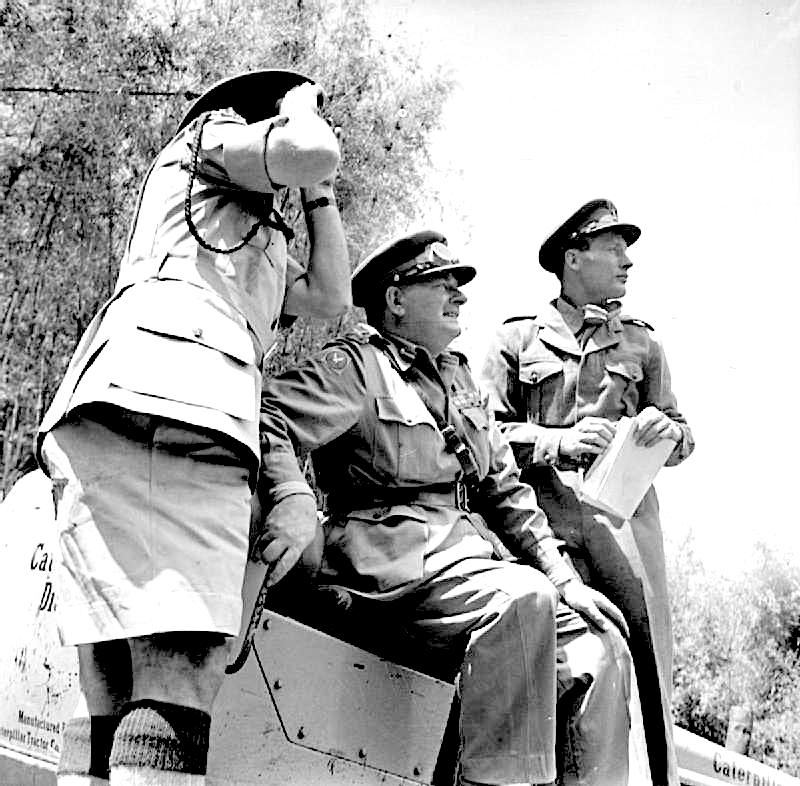Britain’s General Sir Frank Kitson, who died in January, left a terrible legacy in Ireland and a model for countering subversion and insurgency elsewhere, writes Mick Hall. First of an article in two parts.

British troops in south Belfast, 1981. (Jeanne Boleyn, Wikimedia Commons, Public domain)
By Mick Hall
Special to Consortium News
 For Irish human rights lawyer Kevin Winters, Britain’s counter-insurgency campaign throughout Northern Ireland’s “Troubles” can be traced back to one man — General Sir Frank Kitson.
For Irish human rights lawyer Kevin Winters, Britain’s counter-insurgency campaign throughout Northern Ireland’s “Troubles” can be traced back to one man — General Sir Frank Kitson.
The conflict took 3,500 lives, a relatively low number compared with other conflicts, but one that belies a ferocious clash of wills between the Irish Republican Army and the British state, including its paramilitary loyalist proxies.
It can be argued Kitson, who died at the start of January, was chief architect of the torture centres, death squads, psychological operations, extra-judicial killings and an illicit network of agents that featured across 30 years of Anglo-Irish conflict.
For many, Kitson left behind a terrible legacy in Ireland, as well as a lasting sense of apprehension in Britain where, he had cautioned in one of his widely read books, similar methods may need to be deployed to uphold the state’s authority in the future.
Northern Ireland was one of several parts of the world where he left his mark while in the British Army. Having lectured at the Rand Corporation during the 1970s, his tactics were undoubtedly exported even further, via the C.I.A. Evidence of his tactics can be found in places like Iraq.
What makes his time in Ireland stand out is that the crimes he helped to perpetrate were not far away, in a distant colony. They occurred in Western Europe, right up until the 1998 Good Friday Peace Agreement. But these were obscured, many say, including Winters, with the complicity and under the direction of successive British governments.
General Sir Frank Kitson, who died earlier this month aged 97, played a key role in shaping the Army’s tactics at the beginning of the Troubles.
In the latest episode of The BelTel podcast, @CiaranDunbar is joined by historians to discuss the former Army chief's legacy. pic.twitter.com/GIXpEYl27v
— Belfast Telegraph (@BelTel) January 15, 2024
A year after Northern Ireland descended into chaos in 1969, Kitson arrived at Palace Barracks near Belfast as a brigadier. He got to work setting up and overseeing an army intelligence network and “counter-gangs” made up of covert army operatives.
They were sent out to kill IRA activists on sight, or engage in actions to force a change in the behaviour of the organisation or its support base, including using terror to enduce war wariness and reduce an appetite for a prolonged conflict.
Later, such counter-gangs would be largely made up of loyalist paramilitaries aligned with Britain, controlled surreptitiously by the military and a police special branch.
Colonial Britain’s Ugly Backyard
“I think it all harks back to Kitson,” said human rights lawyer Winters in an interview.
“He was definitely at the apex of that policy. You’ve got him there two years at the start of the conflict and he put the template in place within a very short period of time, which then had really long innings after his departure.
“The out-workings of his ‘counter-gangs’ and other techniques morphed and evolved over the years during the conflict to become, I suppose, more sophisticated, but essentially, I think the starting point is that he adopted everything that had been in play in colonial Britain where insurgency took place and deployed it in Britain’s ugly backyard…
In the ’80s and early ’90s, loyalist paramilitaries got ever more sophisticated in terms of targeting republicans, ranging from political leaders, Sinn Fein to IRA activists, to solicitors seen as republican sympathisers. They were getting ever more high-grade intelligence and I lay the blame of that to the door of Kitson.”

British East Africa commander, George Erskine, observing operations against the Mau Mau. (MOD, Imperial War Museums, Wikimedia Commons, Public domain)
Kitson sought to adapt and use what he recognised as “out of date” colonial methods of counter-insurgency he had helped brutally employ in places such as Kenya to suppress the Mau Mau uprising, as well as in Oman, Malaya (Malaysia) and Cyprus.
In 1950s Kenya, Kitson set up gangs of British-friendly Kikuyu tribesmen, who helped ambush Mau Mau fighters in their forest hideouts, or tracked their bases down for British bombers to target them.
He believed that applying more oblique versions of such tactics in a Northern Irish context would involve “an extended period of trial and error.”
Hiding Behind the Law
In his book Low-Intensity Operations: Subversion, Insurgency & Peacekeeping, Kitson also suggested the law needed to be bent to meet the needs of the army, with its counter-insurgency either fitting into or hiding behind the legal framework of Britain’s modern liberal democracy.
In theorizing about the security state, his writing presents contradictory positions that go to the heart of his doctrine of military necessity, namely the notion that in counter-insurgency the military must surreptitiously transcend the rule of law so it can best protect it. He wrote that equality before the law as an operative principle was morally desirable, so that “officers of the law will recognise no difference between the forces of government, the enemy, or the uncommitted part of the population.”
However, he argued that sometimes, of necessity, the “law should be used as just another weapon in the government’s arsenal and in this case, it becomes little more than a propaganda cover for the disposal of unwanted members of the public.”
Discovery of these “Kitsonian experiments,” bringing them into the light of day in court and securing compensation to the state’s victims, has been something to which Winters and his associate litigator Christopher Stanley, alongside victims’ groups and other lawyers, have dedicated many years.
Kitson left Northern Ireland in 1972 after a series of atrocities committed by the British Army and with an IRA target on his back. He took up various roles, including adviser to the Ministry of Defence. He retired after becoming commander-in-chief of the U.K. Land Forces from 1982 to 1985 and acting as aide-de-camp general to Queen Elizabeth II from 1983 to 1985.
Although Kitson’s writings and lectures left a lasting impression on Western security experts and military strategists, his name was largely forgotten after an uneasy peace took root across the north of Ireland.
Case Against Kitson & MOD
That changed in 2015 when Winters’ legal team served legal papers on Kitson and the British Ministry of Defence, accusing them of complicity in a 1973 grenade attack on a bus by loyalist paramilitaries in east Belfast that killed a Catholic man named Eugene Patrick Heenan.
The civil action created headlines and brought renewed attention to the way the government and Kitson’s military boss Harry Tuzo, general officer commanding and director of operations in Northern Ireland, had given Kitson carte blanche to develop and pursue his dark, military-political ideology in Northern Ireland.
In what was meant to be a test case, the action argued that Military Reaction Force (MRF) member Albert “Ginger” Baker, who was convicted for the murder of Heenan and others, could be causally linked to Kitson.
Kitson, who had set up and run the 40-person covert MRF, was accused of “negligence, misfeasance in office and breach of Article 2” of the European Convention on Human Rights, the right to life.
Winters at the time said:
“These are civil proceedings for damages but their core value is to obtain truth and accountability for our clients as to the role of the British army and Frank Kitson in the counterinsurgency operation in the north of Ireland during the early part of the conflict, and the use of loyalist paramilitary gangs to contain the republican-nationalist threat through terror, manipulation of the rule of law, infiltration and subversion all core to the Kitson military of doctrine endorsed by the British army and the British government.”

Kevin Winters. (Courtesy KRW Law)
Winters and Stanley decided not to pursue the conventional approach of suing the state in a corporate capacity or pushing for an inquiry. They viewed civil proceedings as a potentially better way to achieve disclosure and force details of the “dirty war” into the open.
Winters believes the controversial Northern Ireland Troubles (Legacy and Reconciliation) Bill was passed through the U.K. Parliament last year in part to stifle the “latent threat” posed by civil litigation, which compels former security force members and politicians into court.
The bill offers immunity to those accused of murder on condition they cooperate with a commission set to investigate over 1,000 “unsolved” killings. He says:
“With civil litigation, acting on behalf of plaintiffs, on behalf of families and victims, you have an awful lot more control and clout and input into the litigation and legal process compared to Police Ombudsman, Police Investigation and Inquests, where you’re pretty much at the behest of the state in terms of funding, resources, timing, release of information, releasing disclosure, etc. You are kind of reactive to those processes. In civil litigation, you are proactive and you can take hugely lateral approaches.”
Official Inquiries Hindered
Official inquiries into state-run death squads and extrajudicial killings have also seen those leading the investigations hindered by the same state and security apparatus being probed.
The first of several was led by English cop John Stalker in 1984, who attempted to probe the deaths of six unarmed IRA men over a five-week period of 1982, all shot dead by police. His “shoot-to-kill” inquiry faced obstruction and Stalker was threatened, smeared and finally removed from the inquiry.
More recent inquiries have faced less overt hostility, but their reports have been limited by scope and politics, including Sir John Stevens’ three inquiries into state collusion with loyalist paramilitaries.
Stevens concluded in 1990 such activity was “neither widespread or institutionalised.” However, by 2003, Stevens said he had uncovered collusion at a level “way beyond” his 1990 view.
Stevens also faced high-level obstruction, including a tip-off in January 1990 that allowed loyalist British army agent Brian Nelson to flee before he was arrested for questioning by the Stevens team. Nelson had helped paramilitaries target the state’s enemy’s by providing classified army intelligence reports and had helped arrange an arms shipment from South Africa to loyalist paramilitaries in the late 1980s.
Stevens inquiries’ headquarters were burnt down the night before the planned arrest, after phones were cut and fire alarms disabled. He said he believed the incident was a deliberate act of arson that had not been properly investigated.
Peter Cory, a retired Supreme Court of Canada judge, probed six killings where security force collision with paramilitaries was alleged, including in the murders of human rights lawyers Pat Finucane (1989) and Rosemary Nelson (1999).
The Heenan case has been parked in the High Court for nearly four years on a strike-out motion by the British Ministry of Defence, pending resolution of another separate case that Winters and Stanley believe presents more compelling evidence of collusion.
Kitson was never compelled to attend court.
As new evidence became available, Winters and Stanley decided to go with a separate murder involving Baker that they believe presented more compelling evidence to get a state collision test case over the line.
Winters said:
“There are all sorts of other reasons why we decided not to run with Heenan and decided to run with another case. There are a series of other cases linked to Albert Ginger Baker. There’s a cohort of litigation, six or seven cases that we have all directly or indirectly linked to Baker. And, again, we see this as a series of cases that were strong enough to warrant issuing a writ against Frank Kitson himself.”
[Continue with the second part of this article: Leaving Irish ‘Troubles’ for the West – Pt 2]
Mick Hall is an independent journalist based in New Zealand. He is a former digital journalist at Radio New Zealand (RNZ) and former Australian Associated Press (AAP) staffer, having also written investigative stories for various newspapers, including the New Zealand Herald.

I’m struck by how old these Nazis like Kissinger live into advanced old age. I can’t figure out how these criminals endure so long. If the law of Karma was working as it should, such men would have died from various painful conditions long before they have. I’m just now looking into this “contradiction”.
No wonder there is no justice in British courts for Julian Assange.
It seems you may be suggesting something associated with the number of children who are “disappeared” and “unaccounted” for?PP